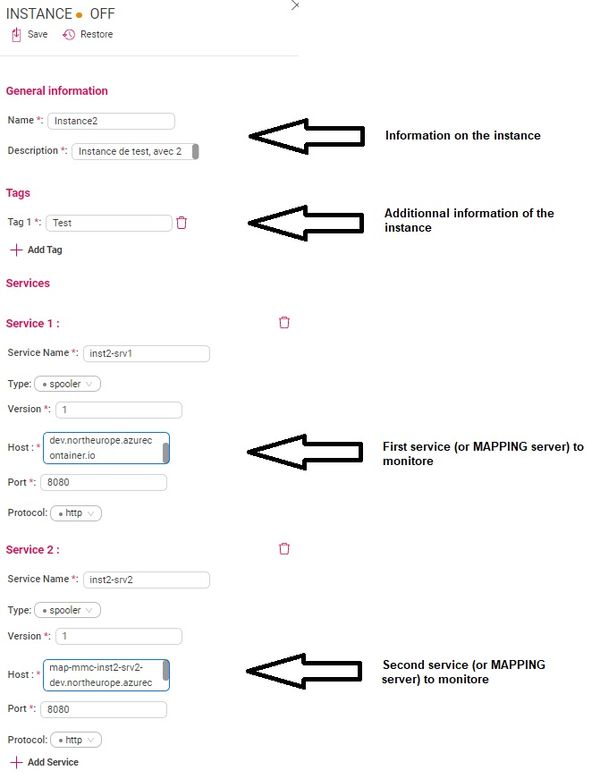ONYX - MMC
ONYX Mapping Management Console/en
Introduction
The centralised console of MAPPING (Mapping Management Console : MMC) gives the possibility to monitore multiple MAPPING servers at the same time through a very intuitive Graphical User Interface. To do so, we need :
- To install NodeJS (v14 minimum) on the machines hosting the MAPPING servers to monitore (prerequisite for the spooler APIs)
- To install the spooler APIs on the machine hosting one or multiple MAPPING environments (1 API spooler per machine) and start them on each of the instance to monitore.
- To install the MAPPING Management Console (MMC)
Prerequisites
- One (or multiple) ONYX MAPPING servers installed and configured (Spooler APIs available and configuration done)
- Install NodeJS (v14 minimum) (Node.js ) on the machine(s) hosting the MAPPING instances to monitore
NodeJS
NodeJS is a prerequisite for the installation of the MAPPING spooler APIs. We provide a example of the installation on CENTOS.
If you run on another distribution, please refer to the installation guide for this distribution.
Example of installataion on centos
curl -sL https://rpm.nodesource.com/setup_14.x | bash - && yum -y install nodejs
APIs Spooler
The spooler APIs must be installed on each of the MAPPING machine (and not environment) to which the MMC must has access to.
In the event where multiple MAPPING environments are installed on the same machine, then the spooler APIs will have to be installed only once on the machine and then start them on each of the environment executing the mappingenv command before to select the instance on which we want to start the Spooler APIs (see chapter on the start of the APIs)
Installation on a VM
mapping-spooler-api command
as mentionned ealier, the spooler APIs must be instanned only once per machine hosting the MAPPING environment(s) to monitore.
The command get installed with npm (packet manager installed with NodeJS).
The npm registery is private and therefore requires an authenfication.
Authentification
npm login --registry http://npm-registry.mappingsuite.com:4873
username : partnermappingsuite
password : (voir sur LastPass : [M-S] IT> NPM Registry for Partner )
email : partner_mappingsuite@mappingsuite.com
Installation
npm install -g mapping-spooler-api --registry http://npm-registry.mappingsuite.com:4873
Installation Avec Docker
L’API Spooler doit absolument être installé sur le même hôte que le serveur Mapping Onyx.
We must therefore add the spooler API installation to the docker MAPPING ONYX image.
Example of Dockerfile
# Base Image Mapping Suite Server FROM mappingsuite.azurecr.io/onyxserver:10.2.0 # NPM Registry Token for Authentication ARG npm_token # Update & Supervisor (for running Onyx + Rest API in parrallel) RUN yum -y install epel-release && \ yum -y update && \ yum -y install supervisor # Install NodeJS RUN curl -sL https://rpm.nodesource.com/setup_14.x | bash - && \ yum -y install nodejs # NPM Private Registry Authentication RUN npm set //npm-registry.mappingsuite.com:4873//:_authToken ${npm_token} # NPM install mapping-spooler-api with private NPM Registry RUN npm install -g mapping-spooler-api --registry http://npm-registry.mappingsuite.com:4873 # Required env var for API REST ENV PORT=8080 ENV MAPPING_PATH=/apps/mapping/data/conf/mapping.conf # Supervisor Configuration RUN echo "[supervisord]" > /etc/supervisord.conf && \ echo "nodaemon=true" >> /etc/supervisord.conf && \ echo "[program:spooler-api]" >> /etc/supervisord.conf && \ echo "command=bash -c 'sleep 5 && exec mapping-spooler-api'" >> /etc/supervisord.conf && \ echo "[program:onyx-server]" >> /etc/supervisord.conf && \ echo "command=/home/docker/scripts/init.sh" >> /etc/supervisord.conf EXPOSE 8080 # Run Supervisor ENTRYPOINT ["/usr/bin/supervisord"]
This Dockerfile uses a parameter "npm_token” to authenficate itself on our npm registery.
A token can be obtained using the following command :
curl -s -H "Accept: application/json" -H "Content-Type:application/json" -X PUT --data '{"name": "mappingdev", "password": "PASSWORD"}' --user mappingdev:PASSWORD http://npm-registry.mappingsuite.com:4873/-/user/org.couchdb.user:mappingdev
Build-up of the image :
docker build . -t onyxserver-api --build-arg npm_token=$TOKEN
Configuration
one the command installed, you need to configure each ONYX server to define the HTTP porte used by the spooler APIs.
This can be done using the mapping.conf entry SPOOLER_API_PORT on each MAPPING server to monitore.
This value must be unique on each ONYX server installed on the VM.
Example
<block name="WEB CONFIG"> <group> <element> <info name="[SPOOLER_API_PORT]">8080</info> </element> </group> </block>
Note:These port numbers will be useful when adding the server to the MMC server interface.
starting the API service
To start the HTTP API, you simply need to run the mapping-spooler-api, while the MAPPING_PATH environmeent variable define on the desired Onyx server.
This kind be done using the mappingenv command to select the desired Onyx environment, then run the mapping-spooler-api.
Note: The mapping-spooler-api command never gives the hand back and does not have an option to run in background.
To run the command in background, we do as follow :
mapping-spooler-api > /dev/null 2>&1 &
(or using tools as supervisor) The SPOOLER_API_PORT option of the mapping.conf is optionnal. If it is not present, the API will look for a environment variable PORT.
Mapping Management Console
Installation
L’installation de l’interface MMC ne peut se faire qu’avec Docker.
Image : mappingsuite/management-console-full
username : partnermappingsuite
password : (voir sur LastPass : [M-S] IT> DockerHub partner )
Exécution sans aucune sauvegarde, avec le user admin par défaut (mapadmin/mapadmin), interface disponible sur le port 8003 :
docker run -p 8003:80 mappingsuite/management-console-full
Il est possible de définir le nom et le mot de passe du compte admin par défaut, via les variables d’environnement ADMIN_USERNAME et ADMIN_PASSWORD, exemple :
docker run -p 8003:80 -e ADMIN_USERNAME=MyAdmin -e ADMIN_PASSWOR=MyPassword mappingsuite/management-console-full
Pour sauvegarder les données (users et instances mapping créés) il faut utiliser un volume sur le répertoire mapping/data
docker run -p 8003:80 -v /my/data/:/mapping/data mappingsuite/management-console-full
Note : L’image docker utilise un user mapping, utiliser un chemin local comme volume risque de poser des problèmes de droits d’accès, il est préférable d’utiliser un volume docker.
Les logs peuvent aussi être sauvegardées avec un volume sur le dossier /mapping/logs.
docker run -p 8003:80 -v /my/logs/:/mapping/logs mappingsuite/management-console-full
Exemple de docker-compose .yml :
version: '3.2'
services:
mmc:
image: mappingsuite/management-console-full
ports:
- "8003:80"
environment:
- ADMIN_USERNAME=admin
- ADMIN_PASSWORD=Mapping1234
volumes:
- mapping-data:/mapping/data
- "/home/mmc/logs:/mapping/logs"
volumes:
mapping-data:
Utilisation
Création d'une instance MAPPING
Une instance est un regroupement d'environnement MAPPING (ou service).
Menu Instances / +Add
A l'intérieur il faut créer des services correspondant aux serveurs MAPPING à monitorer
